Porcelain has always symbolized refinement and sophistication on the dining table. Yet, what truly gives porcelain its enduring shine, smoothness, and resistance to daily wear is a process called glazing. If you have ever admired the glass-like finish on a plate or bowl, you’ve already seen the art of glazing at work. In this article, we’ll explore what glazed porcelain is, uncover seven amazing benefits of glazed porcelain products, and walk you through how porcelain is glazed, step by step.
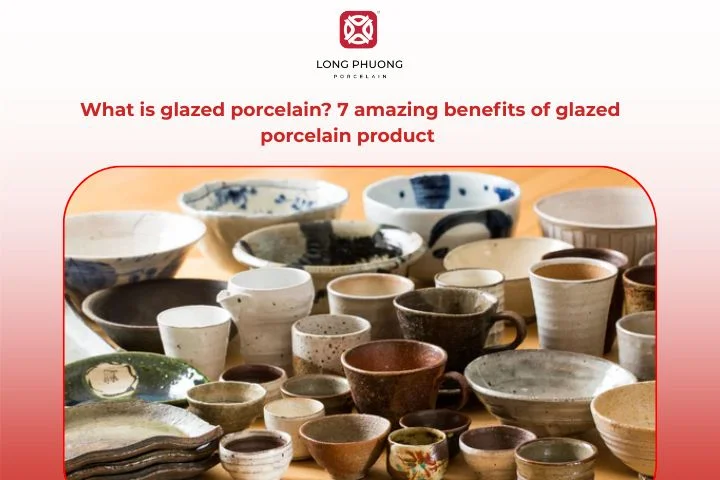
1. What is glazed porcelain?
Glazed porcelain is a type of ceramic tile made from dense clay that is fired at high temperatures, with a protective, glass-like coating applied to its surface before firing. The process involves applying a liquid glaze, made from minerals and silica, to the porcelain surface before it goes into the kiln. When fired, the glaze melts and fuses with the clay body, forming a shiny, protective coating.

Glazed porcelain tableware is widely used for dinner plates, bowls, cups, and serveware because it combines aesthetic appeal with practical benefits. It’s both beautiful and functional – ideal for both casual family meals and luxurious dining settings.
2. 7 great benefits of glazed porcelain you should know
There are countless reasons why homeowners, chefs, and collectors love glazed porcelain. Below are seven of the most valuable benefits of glazed porcelain that make it a top choice for modern tableware.
2.1. Resistant to acratches and everyday wear
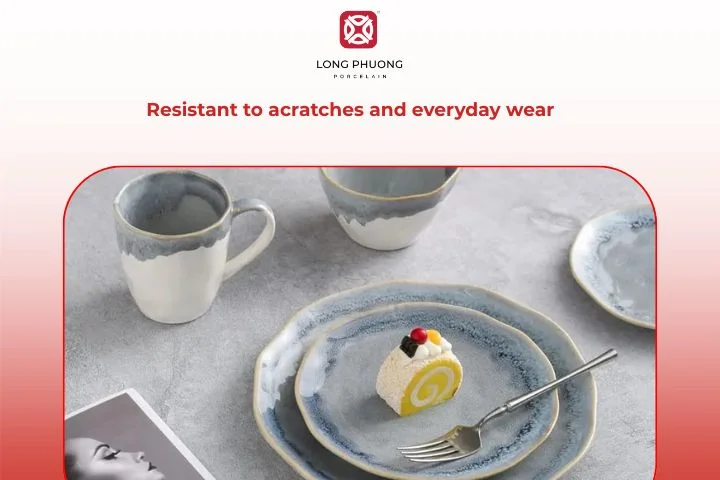
One of the most noticeable benefits of glazed porcelain is its impressive resistance to scratches. The glaze acts as a hard protective shell, keeping your dishes looking new even after years of use.
Whether it’s metal cutlery scraping the plate or stacking dishes in the cupboard, glazed porcelain maintains its smooth and glossy finish. That’s why it’s a preferred choice for busy kitchens, restaurants, and families that use their tableware daily.
2.2. Excellent water and moisture resistance

Porcelain by itself can absorb water if left unglazed. But glazing transforms it into a non-porous material. This means it won’t soak up liquids, odors, or stains.
Glazed porcelain dishes are safe to wash, soak, or store in humid environments without fear of cracking or discoloration. This makes them perfect for both indoor dining and outdoor gatherings where moisture exposure can be a concern.
2.3. Stain and odor resistance
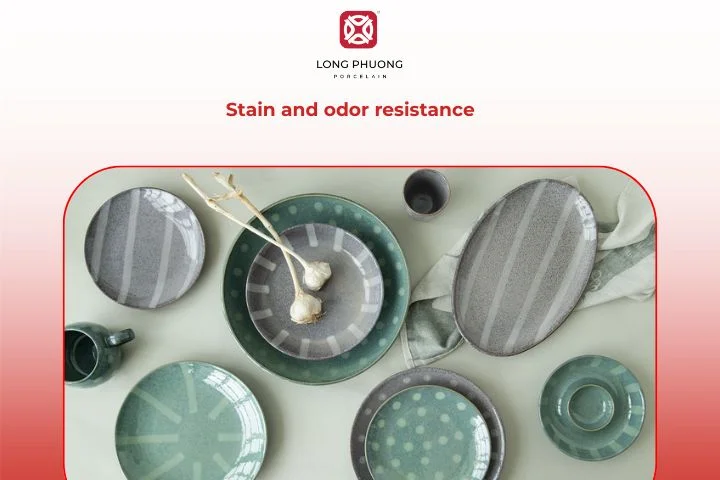
Because the glazed surface is non-porous and incredibly smooth, it actively repels stains. Foods with strong colors, like turmeric, tomato sauce, red wine, and coffee, are easily wiped away without leaving behind a shadow or discoloration.
2.4. Easy to clean and low maintenance
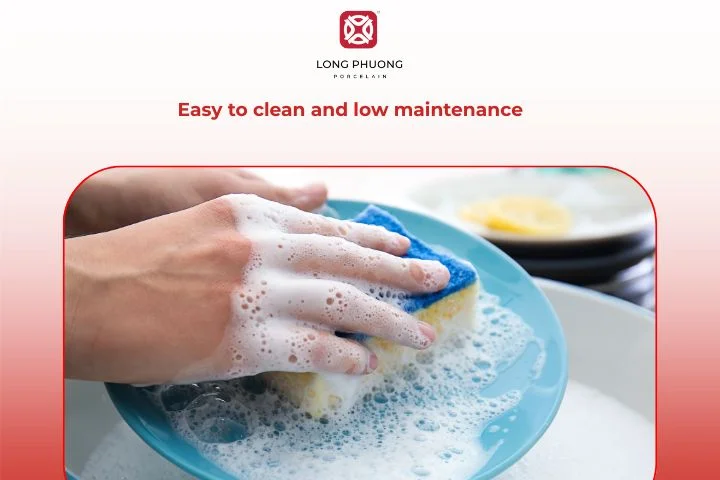
For deep cleaning, glazed porcelain is overwhelmingly safe for dishwashers, making the cleanup process incredibly low maintenance and hassle-free—a significant advantage for busy households and high-volume commercial kitchens.
2.5. Hygienic and safe for food contact
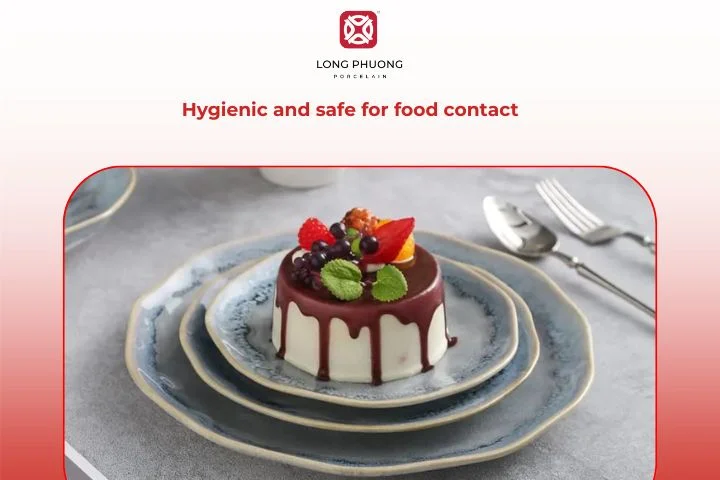
One of the most important benefits of glazed porcelain is its superior hygiene. The completely non-porous, smooth surface is hostile to bacterial growth. There are no microscopic crevices or pores where germs, mold, or bacteria can lodge and multiply.
When using food-safe glazes (which all reputable manufacturers adhere to), the resulting surface is inert, non-reactive, and safe for all types of food, including highly acidic items. This high level of hygiene makes glazed porcelain the gold standard for safe food contact in both professional and domestic environments.
2.6. Elegant design and wide variety of styles

Beyond just shine, the glaze holds the color and decorative elements. Manufacturers can use a vast palette of food-safe pigments to create everything from classic brilliant white to deep, rich colors and intricate patterns. Whether your style is minimalist, traditional, or contemporary, the versatility of the glaze allows for an extensive variety of styles and designs.
2.7. Long-lasting shine and color retention

Due to the intense firing process, the glaze becomes a permanent part of the porcelain body. This thermal fusion ensures that the colors embedded in the glaze do not fade, even after repeated exposure to heat, strong detergents, or UV light.
The glossy finish is also highly durable, meaning that the lustrous shine of your tableware lasts for decades. This long-lasting shine and color retention guarantee that your investment in quality porcelain will continue to look new and vibrant for years to com
3. How do you glaze porcelain at home?
While professional glazing requires industrial kilns, it’s possible to try simple glazing projects at home. Here’s how you can glaze porcelain safely and effectively.
3.1. Prepare the porcelain surface before glazing
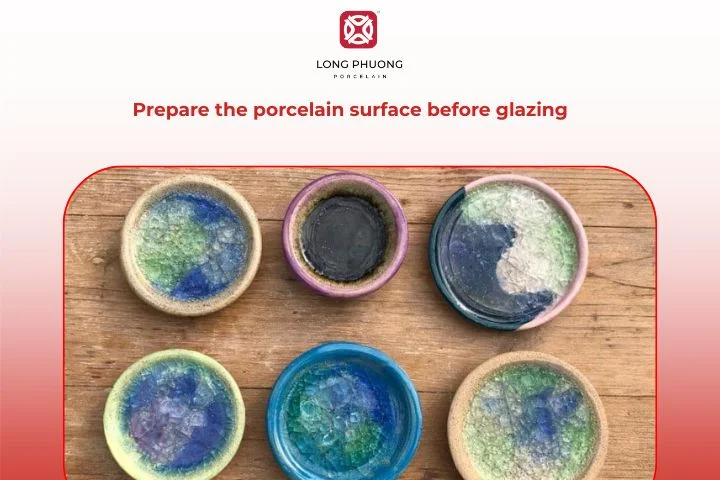
The porcelain piece must be clean, dust-free, and ideally in a bisque state (fired once but not yet glazed).
- Cleaning: Wipe the surface with a damp sponge to remove any dust or oils that could prevent the glaze from adhering properly.
- Handling: Only handle the piece with clean hands or gloves, as oil from your skin can resist the glaze application.
3.2. Choose a food-safe glaze for porcelain
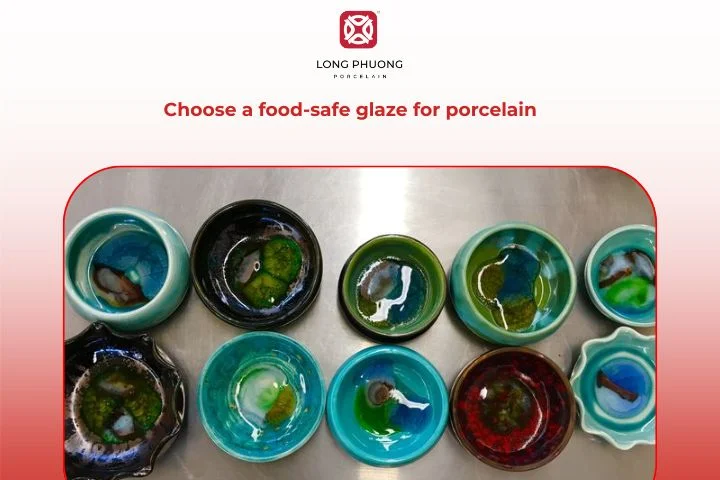
Always choose food-safe glazes designed specifically for porcelain. These glazes are non-toxic and suitable for items that will hold food or drinks.
Look for labels that say “lead-free” and “dishwasher-safe.” Clear transparent glazes are perfect for preserving the natural color of white porcelain, while tinted glazes can add artistic flair.
3.3. Apply the glaze evenly
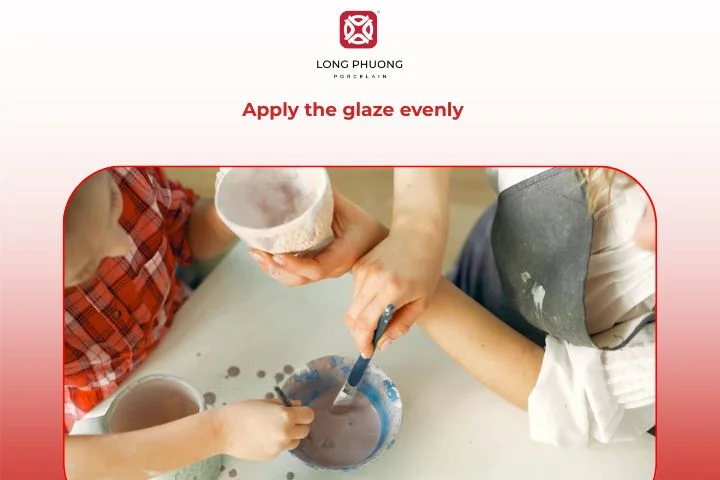
There are several methods for applying glaze, but dipping is the most common for porcelain tableware.
- Dipping: Quickly dip the piece into the glaze bucket, allowing the glaze to coat the surface evenly. Pull it out immediately.
- Pouring: For large or complex shapes, the glaze can be poured over the piece.
- Brushing/Spraying: Can be used for decorative accents, though often results in a less consistent coat.
- Drying: Allow the first layer to dry completely. Apply a second or third layer if required by the glaze type to achieve the desired thickness and color saturation.
3.4. Fire the glazed porcelain in a kiln
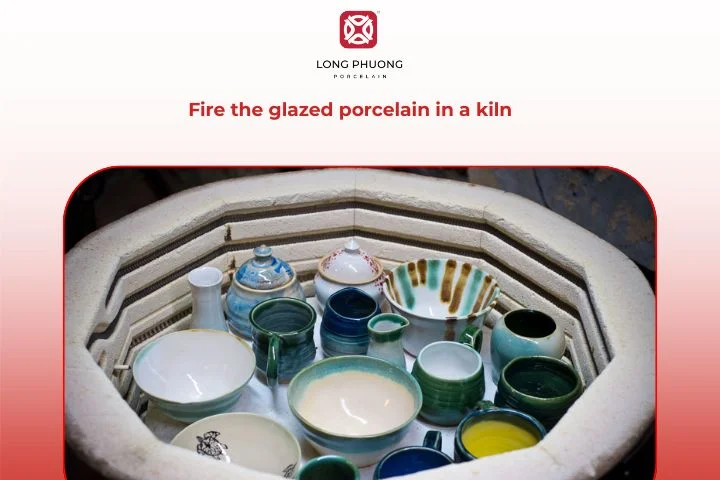
Place the glazed piece in a kiln and fire it according to the manufacturer’s temperature recommendations, usually around 1200–1400°C. This stage melts the glaze and bonds it permanently to the porcelain.
The firing process is what gives porcelain its glassy, durable, and elegant surface.
See more: 12 popular kilns types you should know
3.5. Cool, inspect, and finish the piece
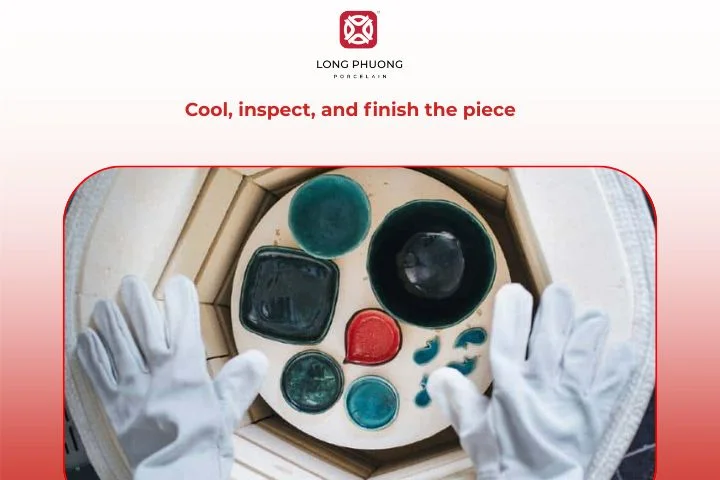
Once firing is done, let the kiln cool completely before removing your piece. Inspect for glaze defects or air bubbles. Wipe gently with a soft cloth – your porcelain is now beautifully glazed and ready for use or display.
4. Video step-by-step porcelain glazing process
5. FAQs
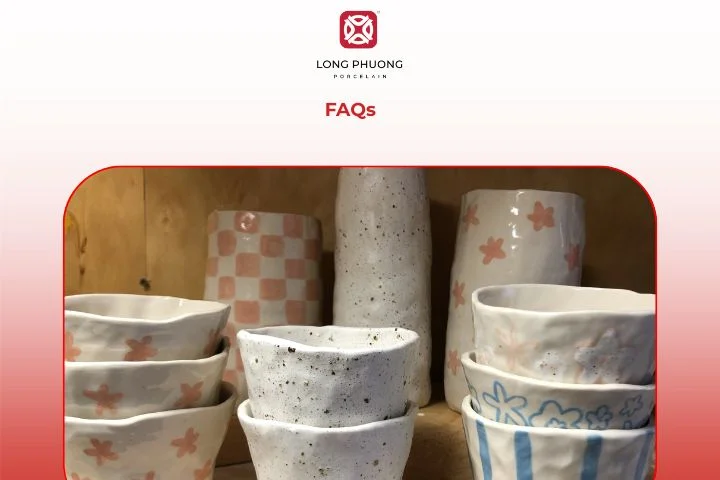
We often receive questions about the performance and care of glazed porcelain. Here are answers to some of the most common inquiries.
5.1. Is glazed porcelain good?
Absolutely. Glazed porcelain is widely regarded as one of the best materials for tableware and dinnerware.
5.2. Are porcelain plates glazed?
Yes, almost all porcelain plates are glazed. The glaze gives them their distinctive shine and prevents moisture absorption, ensuring longevity and food safety.
5.3. Is glazed porcelain safe for microwaves and dishwashers?
Generally, yes. High-quality glazed porcelain is almost always safe for both the microwave and the dishwasher due to its extreme durability and thermal shock resistance.
5.4. What is the difference between glazed porcelain and bone china?
While both are premium tableware materials, porcelain is generally denser and more durable, while bone china is lighter and slightly translucent. Glazed porcelain is less likely to chip, making it ideal for everyday use, while bone china is often reserved for fine dining or collections.
5.5. Can you reglaze old porcelain tableware?
Yes, you can reglaze old porcelain pieces to restore their shine or change their color. However, this should be done carefully with food-safe glazes and proper firing equipment. For valuable or antique items, professional reglazing is recommended.
6. Long Phuong – where to buy high-quality porcelain tableware
Now that you understand the incredible benefits of glazed porcelain, the choice for your next dinner set, plate, or bowl is clear. The key is to source your tableware from a manufacturer that uses only the highest quality raw materials and adheres to precise, high-temperature firing processes to ensure a flawless, durable, and food-safe glaze.
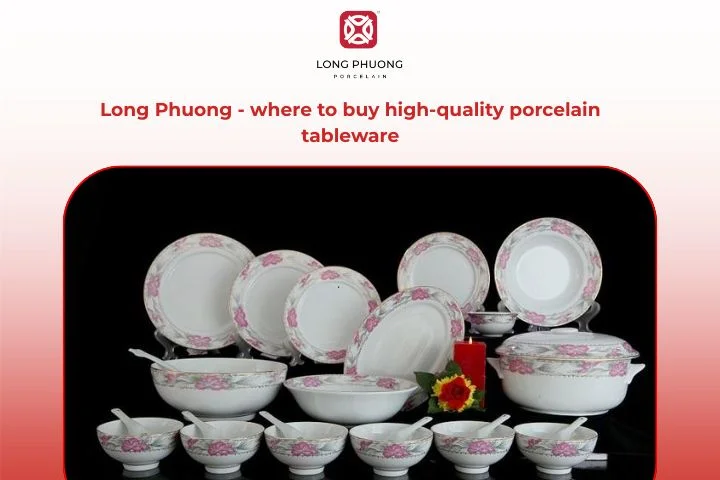
Long Phuong Porcelain has been a leading manufacturer and exporter of premium porcelain products for over ten years. We specialize in creating beautifully designed, highly functional, and supremely durable tableware.
Why choose Long Phuong?
- Premium Glazing: Our porcelain is finished with a proprietary, high-fire glaze that guarantees the ultimate scratch resistance, stain resistance, and long-lasting shine.
- Food Safety Guaranteed: Every piece is fired to vitrification, ensuring a non-porous, hygienic surface that is 100% safe for all food contact.
- Extensive Selection: From classic white dinner sets perfect for any occasion to modern, minimalist designs, we offer a wide variety of styles to elevate your dining space.
- Durability You Can Trust: Our products are designed and manufactured to meet the rigorous demands of both home use and high-volume commercial hospitality environments.
Elevate your dining experience with the lasting beauty and practicality of Long Phuong’s benefits of glazed porcelain tableware. Visit our official website or contact our sales team today to explore our full collections.
Long Phuong Group Joint Stock Company
- Phone number: (+84) 989 595 866
- Email: export@longphuong.vn
- Factory: Hap Linh Industrial Cluster, Hap Linh, Bac Ninh, Vietnam
- Showroom Ha Noi: 59 Cua Bac, Ba Dinh Ward, Hanoi, Vietnam
- Showroom Ha Noi: 37 Cua Nam, Cua Nam Ward, Hanoi, Vietnam
- Showroom TP. Ho Chi Minh: 127 Le Thi Rieng, Ben Thanh Ward, Ho Chi Minh, Vietnam
Related Articles
CEO of Long Phuong Group Joint Stock Company, with more than 20 years of exploration and research to obtain the best formulas and professional experience, Long Phuong Porcelain has produced more than 400 designs of all kinds of household porcelain, Significant contributions to Vietnam's ceramic industry.
 Vietnam
Vietnam
